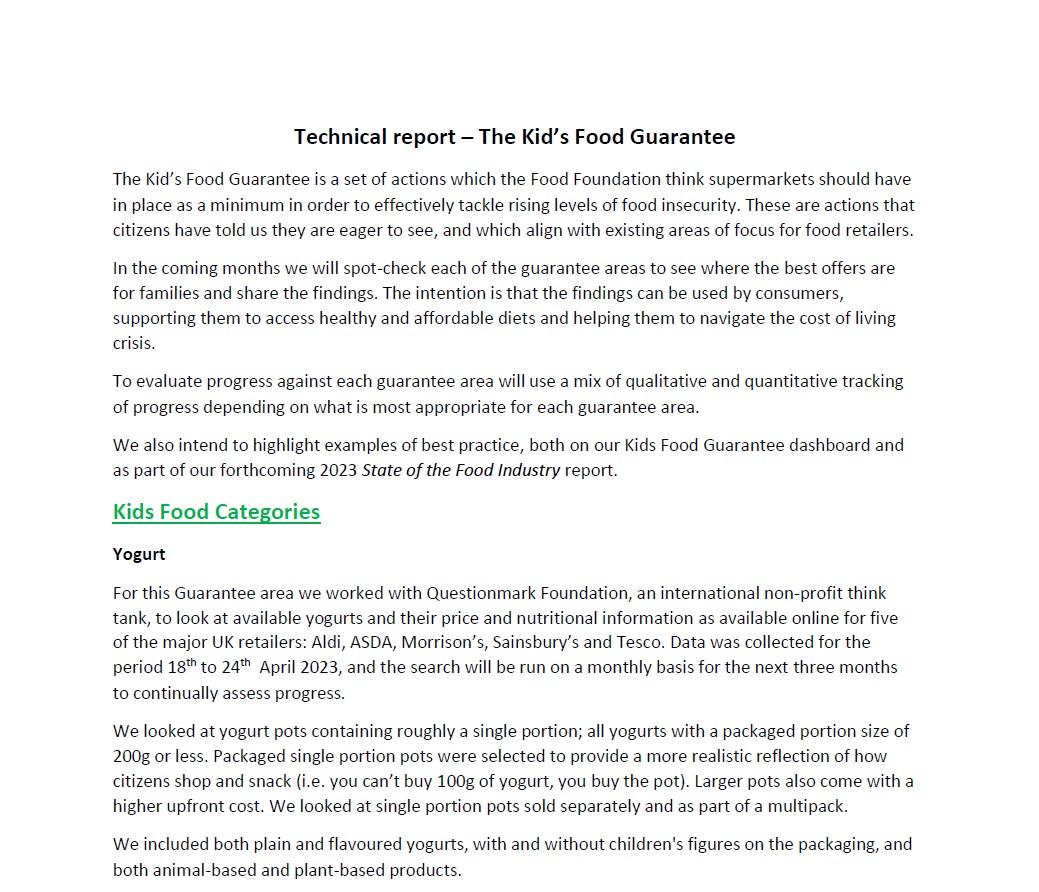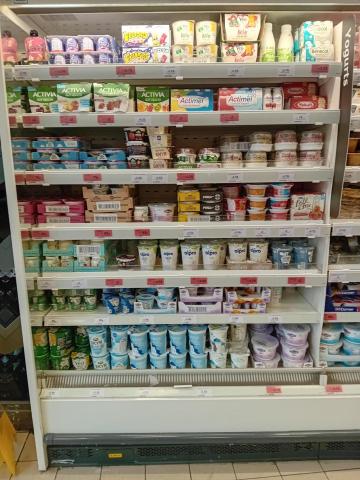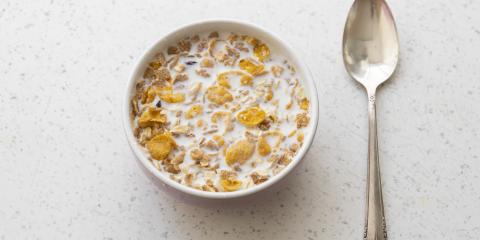
Kids Food Guarantee Update: Yogurt and cereals - September 2023
Yogurt and boxed cereals: how affordable are the healthiest options?
Round two of the Kids Food Guarantee monitoring
The Kid’s Food Guarantee
The Kids Food Guarantee is a set of actions which we think supermarkets should have in place as a minimum if we are to effectively tackle rising levels of food insecurity. These are actions that citizens have told us they are eager to see, and which align with existing areas of focus for food retailers. Better pricing for health is critical in ensuring that low income groups are able to access a healthy diet during the cost of living crisis.
Why yogurt and cereal?
Yogurt and cereals are staple items for many families and are foods that caregivers and parents are often likely to give their children in the belief that they are healthy options. However, despite their potential health benefits many are high in sugar, with both foods in the 10 main categories contributing to children’s sugar intakes.
When we surveyed low income households with children in January, 79% told us they’d like to see retailers make the healthiest children's yogurts and cereals the most affordable.
What did we do?
To monitor this Guarantee area we worked with Questionmark Foundation, an international non-profit think tank, to look at available yogurts and cereals, their price, and nutritional information for the largest five major UK retailers: Aldi, ASDA, Morrisons, Sainsbury’s and Tesco.
Data was collected for the period 19th to 26th July 2023 and compared to data collected for the period 18th to 24th April 2023.
We used the Government’s Nutrition Profiling Model to assess the healthiness of cereals. Using this criteria foods scoring 4 or more points are classified as high in sugar, salt and/or fat (HFSS).

To assess the nutrition profile of the yogurts in scope we looked at the sugar content of yogurt per 100g. We used the upper limit of total daily (free) sugar intake recommended for children as our guide for assessing sugar levels.
For children aged 7-10 this is 24g, equivalent to 6 cubes of sugar. For children aged 4-6 it is 19g, equivalent to 5 cubes of sugar. 4g of sugar is equivalent to a teaspoon or cube of sugar, with 1 cube of sugar (3.8g) per 100g derived from naturally occurring milk sugars in yogurts.
For further methodological details and more information on our inclusion and exclusion criteria, read our technical report, or take a look at our previous yogurt and cereal reports.
What does good look like?
Ideally the cheapest yogurts and cereals would be those with the best health profile. This would support families to access healthy and affordable staple products, so they do not end up with cheaper products which are less healthy. Given that new product development and reformulation of food items can be a lengthy process, we anticipate that price is likely to change more quickly than the nutritional profile of yogurts and cereals.
Has the cost of yogurts and cereals changed since April?
The average cost of single portion yogurt pots increased by 3p between April and July (from 62p to 65p), increasing by an average of 3p for branded yogurts and 2p for retailer own brand yogurts.
For cereals, the average cost per 100g of cereal decreased by 1p between April and July (from 58p to 57p), with an average increase of 2p for retailer own-brand labels and a fall in the average price of branded cereals of 4p.
Although these are small changes in price they can nonetheless all add up in the context of a household’s weekly food shop. The trend towards increasing prices for supermarket own brand products is concerning, given that food inflation reduced from 19.1% in April to 14.9% in July, suggesting that consumers are not yet seeing the benefits of falling inflation.
Has the nutrition profile of yogurts and cereals changed since April?
There has been little change in the nutritional profile of the yogurts and cereals available. A third of cereals on offer (32%) remain high in salt, fat or sugar (HFSS), while over half (53%) of yogurts contained four cubes or more of sugar per pot.
Although yogurt contains naturally occurring sugars (equivalent to 1 cube of sugar per 100g), children aged under 4 should avoid free sugars, and the recommendation for children aged 4-6 is no more than 19g a day (5 sugar cubes). Many yogurts may therefore be contributing a very high proportion of the recommended daily sugar intake to children’s diets in a single serving.
Although still only a very small sub-category, one encouraging change is that the number of plain, unsweetened single portion yogurts available to buy has increased (albeit only by one), with a new Morrison’s 200g plain Greek yogurt product identified in July’s analysis.
However, there are still only 13 plain, unsweetened yogurts sold in single portion pots out of the 372 products we looked at.
The average price of an unsweetened, plain yogurt is £0.83 per pot. This remains much higher than the average price of £0.65 for sweetened and/or flavoured yogurts. Just 8% of the single portion yogurts in our sample can be classed as low sugar (containing under 5g of sugar per 100g) with 92% containing more than 5g of sugar.
Has anything changed for the lowest cost yogurts and cereals with the best nutrition profiles?
In July, those yogurts with the lowest sugar content for the lowest price in each of the five retailers we looked at were a mix of branded and own-label products. Of these five yogurts, two hadn’t changed in price since April and one had increased in price (at Morrison’s). (1)
Overall, the average price of the five lowest cost yogurts with the lowest sugar content was 41p in July.
In the cereal category, supermarket own-brand cereals still offer consumers the most affordable and healthiest options by quite some way, costing just 36p per 100g of cereal compared to 63p for branded cereals.
Those cereals costing the least per 100g for the best (lowest) NPM score across the five retailers remain the same group of products as in April.
There have been no price changes in the cost of the lowest priced, healthiest options at four retailers since April and a decrease in the healthiest, lowest cost option available at Morrisons.
Has anything changed for the lowest cost yogurts and cereals with the poorest nutrition profiles?
There has been little change in those yogurts that are low cost (<£1) and extremely high in sugar. A Muller branded yogurt (the Muller Bliss Lemon Greek style yogurt) was the cheapest yogurt with the highest sugar content (containing six cubes of sugar, five of these added) across four of the five retailers we looked at once again. While the price of the lowest cost yogurts with the highest sugar content increased at two retailers (Sainsbury’s and Tesco) it decreased at two (ASDA and Morrisons) and stayed the same at Aldi.
In the cereal category, the cereals with the lowest cost per 100g for the highest (worst) nutrition profile had changed slightly across the five retailers although a Kellogg's branded cereal (Kellogg’s Crunchy Nut Granola Chocolate & Hazelnuts) remained the cereal with the highest (worst) NPM score for the cheapest price for a majority (three) of retailers. Of this group of cereals, two saw no price change from April (Aldi and Tesco) and three of the products increased in price between April and July (Sainsbury’s, ASDA and Morrisons).
Are supermarket own-brand cereals healthier than their branded equivalents as well as being cheaper?
Given the notable price difference between branded cereals and the supermarket own-brand versions, we wanted to explore in more detail whether these own brand products were superior in terms of their nutrition profile.
We took the average price for three well-known branded cereals (e.g. Kellogg’s cornflakes) sold across the five retailers in scope and compared the price and NPM score to the retailer’s own-brand versions.
For all three of the cereals we looked at supermarket own brand versions were lower cost and generally had a better (lower) NPM scores than the branded equivalent.
Supermarket own-brand options offer families healthier, lower cost options with opportunity for manufacturers (who have the largest share of the UK cereal market) to reformulate and improve the nutrition profile of their hero brands.
What we want to see
With food price inflation starting to fall we would like to see the fall in input and production costs being passed through to consumers as quickly as possible.
Unsweetened yogurts are not only in short supply (they make up less than 4% of the single portion yogurts on offer) but they are also 28% more expensive than sweetened yogurts on average.
Of the eight products in the yogurt and cereal categories that offer consumers the best health profile for the lowest price and could be compared with price data from April, six hadn’t changed in price since April and only one had decreased in price.
With levels of food insecurity remaining stubbornly high, at 17% of all households in July, more urgent action needs to be taken to ensure that families are able to adequately feed their families as we head into Winter.
There remain opportunities for retailers and manufacturers to improve the health profile of the cereal and yogurt categories as a whole in the medium and long term.
Low cost, unsweetened yogurts in smaller more convenient pot sizes ought to be more readily available, and there needs to be a shift towards a higher proportion of lower sugar yogurts and cereals.
__________________________________________
(1) We were unable to compare the two yogurts identified in July’s data as having the lowest sugar content for the lowest price to their price in April for two retailers, Sainsbury’s and Aldi





